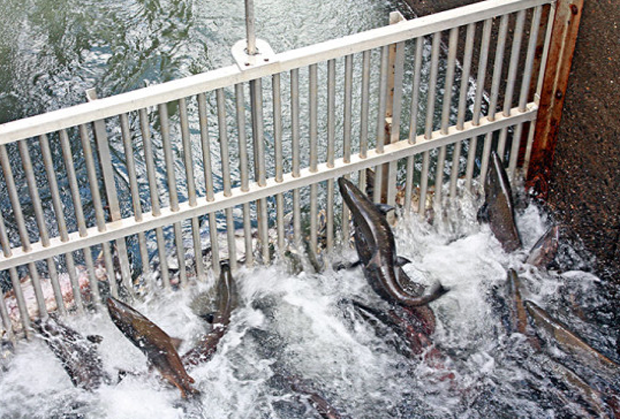California fish evacuated from American River hatcheries due to drought
By Matt Weiser / mweiser@sacbee.com![]()
The California Department of Fish and Wildlife on Tuesday will use tanker trucks to remove about 1 million trout from the American River Hatchery. From there, they will be planted throughout the state as usual – mostly in Sierra Nevada lakes – but at a much younger age and smaller size.
The department also will release 430,000 Central Valley steelhead from Nimbus Hatchery into the American River – about six months earlier than usual. These fish will also be smaller than usual, which means they will be less likely to survive to adulthood, said William Cox, hatchery program manager for the department.

Nimbus Fish Hatchery (A.K.A. American River Hatchery). Photo credit California Department of Fish and Wildlife.
Water temperatures of 78 degrees are considered lethal to rainbow trout and steelhead. Cox said temperatures in the American River are projected to become that warm later this summer because there is so little mountain runoff, and because Folsom and Nimbus reservoirs are already so depleted. They have no reserve of cold water to help fish survive.
The water doesn’t have to get that warm before the fish are harmed. They’ll begin showing signs of stress and disease once water temperatures reach 65 degrees.
Cox said the plan to evacuate the hatcheries resulted from difficult choices that began in January when it became clear a severe drought was taking hold in the state. The goal is to give the fish more options to survive and avoid “major losses” that could occur if they were held in the hatcheries.
“We wouldn’t want to let these fish just sit there and cook,” Cox said.
So far, no other state hatcheries are being evacuated. However, state and federal officials earlier this year took extraordinary measures to protect some 12 million hatchery salmon from warm water temperatures and low river flows throughout the Sacramento Valley. Most of those Chinook salmon made their downstream migration in tanker trucks on the highway, rather than the Sacramento River, as a means to assure that more of them can survive the drought.
Read more here . . .
Call The Bee’s Matt Weiser at (916) 321-1264. Follow him on Twitter @matt_weiser.

